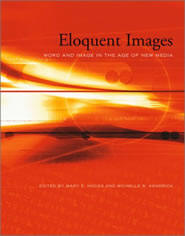
Home / Introduction / Part I / Part II / Part III / Part IV / Conclusion

Conclusion
In summary, the book does prompt us to question how we consider word and image and how we construct and analyze the complex meanings related to such a study. Perhaps because new media is still problematic, questions about new media are still in the forefront in many scholarly circles. However, a book like this can provoke us to reexamine our perspectives and to renegotiate how we define new media. Those of us who work in the humanities will find this book useful in that it asks us to reflect on the ways we think about, discuss, and apply words and images in our cultures. Hocks and Kendrick contend that when we do think about, discuss, and apply words and images in our cultures we must do so by acknowledging the interplay between new media theories and practices that do and have existed throughout history. They hope that by acknowledging the dialogic relationship between word and image, we can avoid the tendency to create word/image binaries that limit our understanding of new media. They also hope that by considering more possibilities for new media we will be able to better construct and analyze our own texts.
Home / Introduction / Part I / Part II / Part III / Part IV / Conclusion